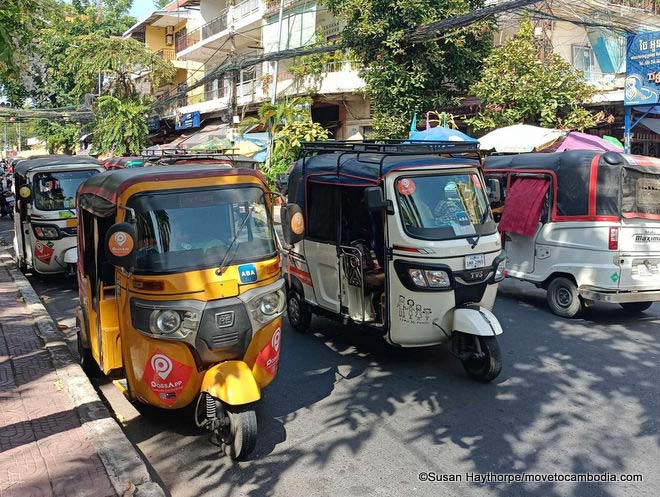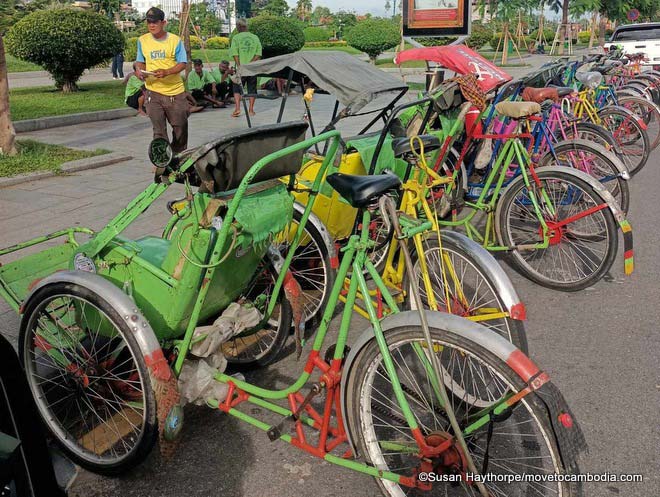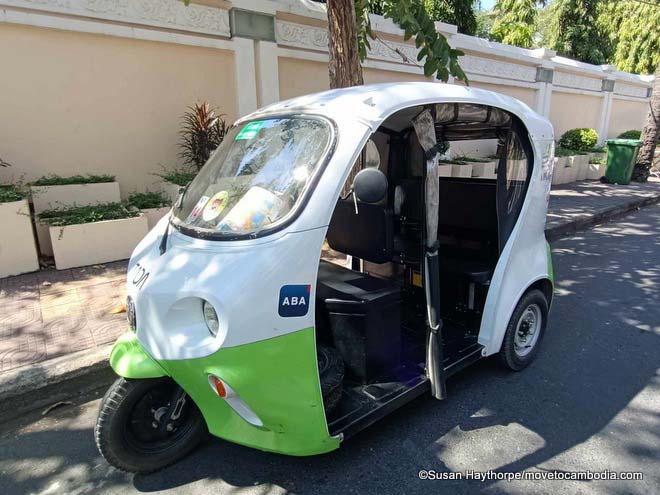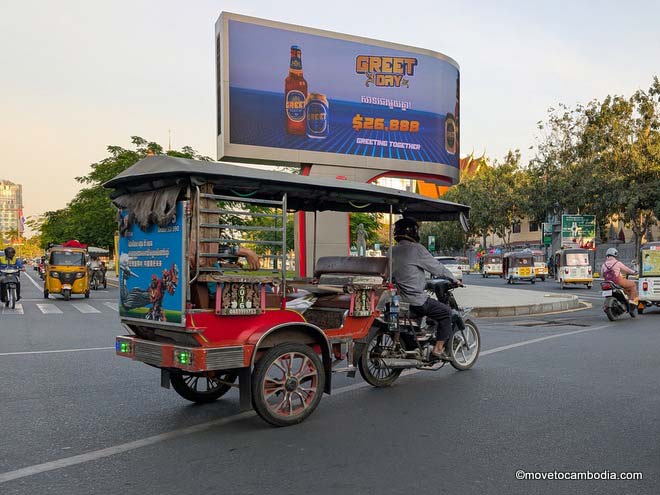The traditional Khmer tuk tuk in all its quirky glory is one of the iconic images of Cambodia. Despite an influx of alternatives, these two-wheeled carriages, known as remorques from the French term for trailer, and usually drawn by the ubiquitous Honda dream, are still an appealing way to get around the city. Time was, remorques were the standard means of transport in Phnom Penh alongside the moto, or motorcycle taxi, and cyclo, the equally iconic Cambodian rickshaw. They first appeared in Cambodia in the 1990s as motorbike ownership grew and by the turn of the millennium were overtaking the cyclo as the staple way to travel.

Phnom Penh is teeming with tuk tuks.
The growing popularity of Indian Bajaj tuk tuks, also called autorickshaws, since the first fleet was launched in Cambodia in 2016 posed a threat to the future of the traditional remorque and has shaken up the capital’s public transport framework significantly. These dinky, agile LPG vehicles, greener, cheaper to use — and to buy and operate — truly came into their own when the first ride hailing apps were introduced the following year. It wasn’t just the remorques and their drivers who suffered the fall out, but the city’s motodops were pretty much put out of business, too.
The cheap fares, convenience and the fact that a whole Khmer family can squeeze into one have made three wheelers the go-to ride for both locals and foreigners. The ability to work for the ride-hailing companies without owning their own vehicle has attracted many younger drivers, usually with some English language skills, a bonus for non-Khmer speakers. The humble cyclo, meanwhile, has been sidelined as a scenic way for tourist ‘cyclocades’ to take in the sights or for locals to get their wares to the market.

Tourist cyclos at the ready in Phnom Penh.
Unlike most major Asian cities these days Phnom Penh is still without a sky train or Metro system, though plans to develop them have been mooted for years, so public transport around the capital is restricted to the increasingly busy roads.
What are the options for travel around the capital?
First of all, a ride-hailing app will save time, expense, the need to haggle over price and to navigate to your destination, and will also handily circumvent the three tier price system for locals, expats, and tourists. It’s still easy to stop any tuk tuk on the street as drivers still cruise for fares, or to pick one up outside your home, hotel, or other venue, though you’ll probably be asked to pay a little more so be prepared to negotiate. Tuk tuks operate round the clock every day of the year, although there may be fewer available overnight and at public holidays.
Cambodia’s first ride-hailing apps, the locally-developed PassApp, and Grab, Uber’s South East Asian operation, remain the most popular and frequently-used. Both offer the choice of Khmer tuk tuk (remorque) or three wheel tuk tuk, including the slightly roomier Maxima. You’re likely to wait slightly longer than the general three or four minutes for a Khmer tuk tuk as there are fewer of them signed up to the apps, and it’s worth noting that some old school drivers are inexperienced map readers so you may still need to provide some directions. For a more luxurious, air-conditioned ride these apps have the option of a range of taxi cars, a wise choice safety-wise on nighttime roads and for the airport route where motorbike bag-snatchers may be at work. In fact, it’s sensible to keep a hold on your bags whenever you travel by tuk tuk, just in case.

Tada’s distinctively shaped Onion tuk tuk.
Relative newcomer, Tada, is the ethical app choice as its drivers pay zero commission and the company’s rosta of vehicles includes its own electric vehicles that it calls Onions because of their distinctive shape. Other apps exist, like Zelo, WeGo, Move and Eagle but tend to have fewer drivers.
Costwise, the apps have brought prices down, a bonus for passengers if not for the drivers. With PassApp, Grab, Tada and Zelo at least you can link a Visa or debit card to your account for direct payment — a major convenience. If you pay by cash try to have change as drivers rarely do. Many drivers will now accept payment by bank QR code, a popular way to pay for everything in the Kingdom. Within central Phnom Penh you can now get a ride for between 75 cents and around $2. A 4km ride, for example, costs around 6,600 riels ($1.70) by tuk tuk, 8,000 riels ($2) by remorque, and 12,000 ($3) riels in a standard car.
With such cheap and convenient door to door travel at your fingertips there’s little need to look elsewhere for your ride, however Phnom Penh has operated a fleet of City Buses since 2014. The concept was slow to take off and the service is still not well-used, but it continues to develop and currently has 13 routes. There are bus stops around the city — though you’re more likely to see the shelters used for a quick, shady nap than to wait for a bus (don’t expect find a timetable at the stop!). All fares are 1,500 riels (around 35 cents) so it’s a cheap choice for longer journeys and there’s an official City Bus app for route information though I can’t testify to its functionality.

Save the Phnom Penh remorque!
Save our traditional tuk tuks!
Thankfully, remorques are hanging in there with their smaller, nippier and increasingly more prolific rivals. Many Bajaj drivers have even customized their tuk tuks to resemble the old favourites by adding decorative steelwork and other traditional-style enhancements. The uptick in Phnom Penh’s tourist numbers this year has been good for the Khmer tuk tuk as visitors find the airy, scenic ride provides a better chance to take in the vibrant city. Let’s follow their example and support our remorque drivers and their trusty chariots lest we end up losing them!
Leave a Reply